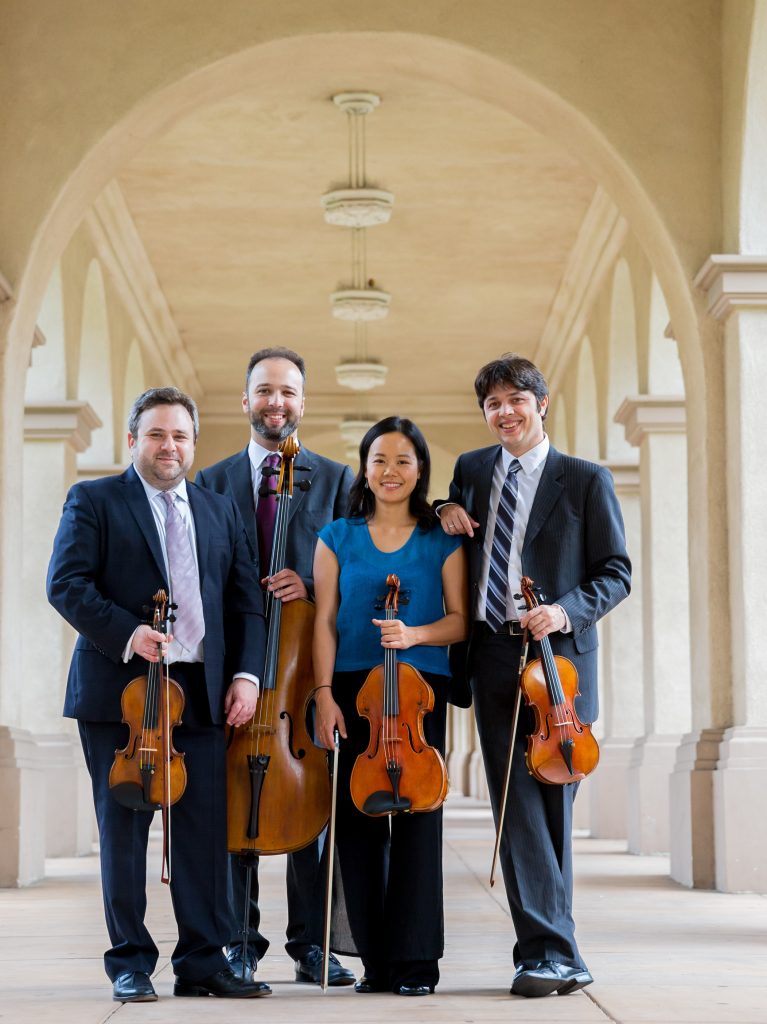The Hausmann Quartet Complements Haydn with Darius Milhaud, Caroline Shaw, and Max Vinetz on its Latest Haydn Voyage Concert
The Hausmann Quartet offered another Haydn Voyage concert Sunday at the Maritime Museum of San Diego, a judiciously balanced program comprised of two contemporary string quartets, an unjustly neglected gem from the last century by Darius Milhaud, and one of Haydn’s most accomplished later quartets, his Quartet No. 64 in D Major, Op. 76, No. 5.

Hausmann Quartet: Bram Goldstein, Alex Goldbaum, Angela Choong & Isaac Allen [photo courtesy of Hausmann Quartet]
Hausmann gives Haydn’s Allegro movements—in this quartet the opening movement and the Menuet—a supple, polished verve that aptly mirrors the composer’s essential optimistic worldview. In the first movement I was impressed with first violinist Isaac Allen’s spacious account of the expansive main theme, as well as the vibrant contrapuntal extensions his colleagues gave it. Although the composer marked his slow movement mesto (sad), Allen gave Haydn’s themes a more persuasive, comforting character that cellist Alex Greenbaum enriched with welcome resonance and violist Angela Choong echoed with perceptive depth.
The ensemble found an ingratiating jovial edge to the Menuet, even when the composer transposes his theme into a minor mode, and their well-disciplined exuberance in the presto Finale could not have been more rewarding.
As a prominent Jewish composer, Darius Milhaud realized the danger of remaining in his native France during the Nazi occupation, so Milhaud spent the war years and a few more in Oakland, California, composing and teaching at Mills College. In 1945 he completed his Quartet No. 12, Op. 252—yes, Milhaud was a prolific composer—but its musical language, especially the charming, lyrical themes of the quartet’s first movement, reveals no hint of wartime. It is, however, a serious piece in which the composer eschews his cocky trademark splashes of dissonant bitonality.
I enjoyed the peaceful themes of the second movement that frequently move in quaint parallel motion, perhaps a nostalgic evocation of earlier, less fraught times. Hausmann handled the closing movement’s breathless contrapuntal excitement, an affirmation of the composer’s vaunted Parisian sophistication, with commendable finesse.
The music of Caroline Shaw has found a welcome in many San Diego venues, from her local debut as a singer and composer in the 2013 Carlsbad Music Festival to the Chanticleer concert at St. James by-the-Sea Episcopal Church at the beginning of this month, where we heard her disarming patriotic anthem Her beacon-hand beckons. Shaw’s Plan & Elevation: The Grounds of Dumbarton Oaks salutes the noted research institute located in Washington, D.C. Shaw completed this work in 2015 when she was in residence at Dumbarton Oaks..
In spite of Shaw’s descriptive titles for each movement, unlike Mussorgsky’s Pictures at an Exhibition, her Plan & Elevation creates moods that she associates with places on the Dumbarton Oaks grounds rather than providing literal musical depictions. Shaw’s voicing of this quartet displayed her dependable ingenuity and ability to refresh the language of the string quartet at every turn. For example, she wrote mesmerizing unaccompanied duets in the closing movement for the violins, deftly executed by Isaac Allen and Bram Goldstein. Elsewhere in this work, however, her reliance on bland, ascending or descending diatonic motifs proved disappointing, and not even Shaw’s technical facility could redeem the opening movement’s “do-re-mi” theme.
The music of the young American composer Max Vimetz is new to me, but I found his 2020 Stars on the Ground accomplished and appealing. Like Shaw, he emplys a flinty modernist harmonic palette and generously employs the various string options besides bowing, e.g. pianissimo high harmonics from the violins and robust pizzicato notes from the cello’s lowest range, to vary the expected string quartet texture.
This concert was presented by the Hausmann Quartet Sunday, May 21, 2023, at the Maritime Museum of San Diego located on San Diego Bay.

Ken Herman, a classically trained pianist and organist, has covered music for the San Diego Union, the Los Angeles Times’ San Diego Edition, and for sandiego.com. He has won numerous awards, including first place for Live Performance and Opera Reviews in the 2017, the 2018, and the 2019 Excellence in Journalism Awards competition held by the San Diego Press Club. A Chicago native, he came to San Diego to pursue a graduate degree and stayed.Read more…
